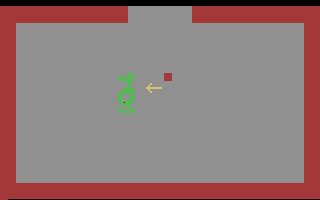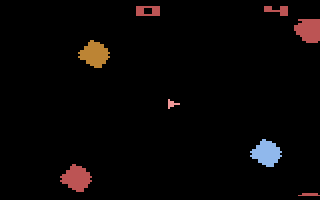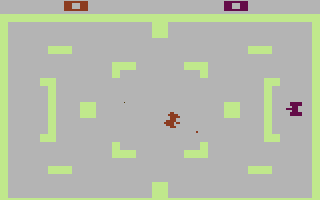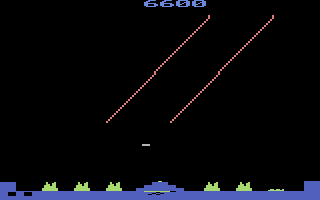Classic Games Emulation | News | Systems | Emulation | Emulators | Games | Links
Atari 2600 Games
Adventure
Atari, 1980

Adventure, released in 1981, was one of the first adventure games (as its name suggests). In many ways it plays more like an action game, but the concept of having to fulfill a quest remains. The player must search for a golden chalice to win the game, but, of course, many obstacles oppose him, including dragons (who eat the player), bats (who steal items from the player), and labyrinths. Appropriately, the player has at his disposal an inventory of objects including a sword (for killing dragons), keys, a brigde (for getting over walls), and a magnet (for pulling multiple objects along or pulling objects out of walls), assuming that he can find the objects.
The quest idea of Adventure became the defining characteristic of later adventure games. One distinctive feature of Adventure (which helped to maintain its popularity long after its graphics should have supported it) is its option to produce randomized maps, which maximized game interest and replay value.
[The first text based adventure game was also called Adventure. The two are not related.]
Asteroids
Atari, 1981

Asteroids is a port from the arcade version. The original used high-resolution, black-and-white vector graphics, as opposed the 2600 version's colorful but chunky graphics. The original was also considerably more difficult than this version, though this port does, however, manage to retain much of the action of the original.
The object is to survive as many levels as possible (and score as much as possible) by destroying the asteroids moving down the screen before they collide with the ship. As the asteroids move, they begin to move laterally as well, so that over time they move directly over the center of the screen and into the path of the player's ship. The player's ship can be moved, but it does obey inertia, and movement in one direction must be compensated for by accelerating in the opposite direction in order to stop.
Asteroids is a simple shooter, pure in all respects, with concentrated, uncomplicated gameplay. I personally have been known to play for an hour and a half straight, which is pretty good game time for anything besides Dark Forces or Colonization.
Battlezone
Atari, 1983

In Battlezone the player must control his tank from a first-person perspective, trying to eliminate as many enemy alien vehicles (including tanks, planes, and flying saucers) as possible. A radar display at the top of the screen indicates the location of other vehicles relative to the tank.
Battlezone's first-person perspective, which was an uncommon feature in its time, not only made Battlezone a unique game, but it also enhanced gameplay, making it a more interesting game as well. The action is relatively fast-paced; the gameplay is slightly complicated due to the perspective, requiring use of a radar screen and many evasive maneuvers, but is still simple enough to keep the game interesting.
Combat
Atari, 1977

Combat, the cartridge originally sold with the Atari 2600 for many years, is unfortunately disdained by too many people because of its ubiquity.
It is characteristically a two-player-only combat game. There are two primary modes, a side-view air combat mode, but, more notably, an overhead tank battle. The game allowed many options, including invisible tanks and richocheting bullets. The only object is to have more kills when time runs out.
Combat is perhaps the greatest two-player game of all time. It was one of the first, and its simple gameplay was addicting and unencumbering: two evenly matched human opponents fighting each other at close range (i.e., not over a network). I personally love this game. Playing it with friends is the greatest kick video games ever produced.
Missile Command
Atari, 1981

Missile Command is another port from an arcade game. The original used a trackball, though on the Atari, the joystick is the only available control option. The player must destroy incoming missiles by firing intercepting missiles from his central base in order to prevent his six bases from being destroyed . The cursor controls where the missiles are fired and detonated. Like many similar defense games, the object is to survive as many waves as possible with as high a score as possible. Missile Command shares many characteristics with other shooters, but the cursor method of control is unique. With simple gameplay but unique control and some variety in play through different attacking missile types and speeds, Missile Command is one more example of the uncomplicated, and hence addicting, shooters of the classical era.
River Raid
Activision, 1982

River Raid is a simple vertical scroller (one of, if not the first) in which a player must move from stage to stage by destroying bridges which seperate each section. The player may not move the plane over the land or any obstacles, all of which must be avoided laterally or destroyed. River Raid was considered to have relatively good graphics in its time. It is a favorite of many classic gamers.
Solaris
Atari, 1986

Solaris, developed by Douglas Neubauer, was one of the last mainstream 2600 games released, and regarded by most as the most advanced cartridge game ever made for the Atari (although some of the Supercharger tape games were quite impressive). It had good, detailed graphics, and several different maps for different sectors of space, which was rather uncommon for Atari games of this genre (cf. Star Raiders).
The object of Solaris is to move through different sectors, protecting allied planets from various enemies, but ultimately in a quest to find the planet Solaris. Movement between subsectors occurs on a map screen, but the player controls his ship after warping with a tail-oriented third-person-perspective view. He must eliminate all enemies in an area to clear it. If enemies are not eliminated, they will (depending on their type) eventually attack a friendly planet (if present in that sector), at which point all controls are reversed (i.e. left on the joystick moves the ship right), making the craft quite difficult to maneuver. As the game progresses the enemies move more rapidly, increasing the challenge of play.
Solaris is a rather difficult game (I have never come close to completing it). Its gameplay is somewhat complex due to its different modes, but gameplay within each is simple, yet challenging and interesting. Solaris is largely of intertest to hardcore Atari gamers, but is still a solid game on its own.
Warlords
Atari

Warlords, originally an arcade game, is an interesting twist on the ball and paddle idea. Players (up to four) must defend their "castle" (situated in one of the four corners) by moving their paddle around the castle (the paddle moves along an L-shaped path). Each time the ball hits a castle it removes one more block (as in Breakout). If it hits the person inside of the castle, that player is eliminated for that round. The last player to be eliminated scores a point, and then play progresses to the next round.
Warlords is certainly one of the most interesting and innovative paddle games I have ever played. Its action can be intense, but it is well paced because the ball does not only hit one player's castle, of course. Its simple gameplay is very addicting.
About CGE (including contact information)
Created April 24, 1998.
Last modified September 28, 1998.